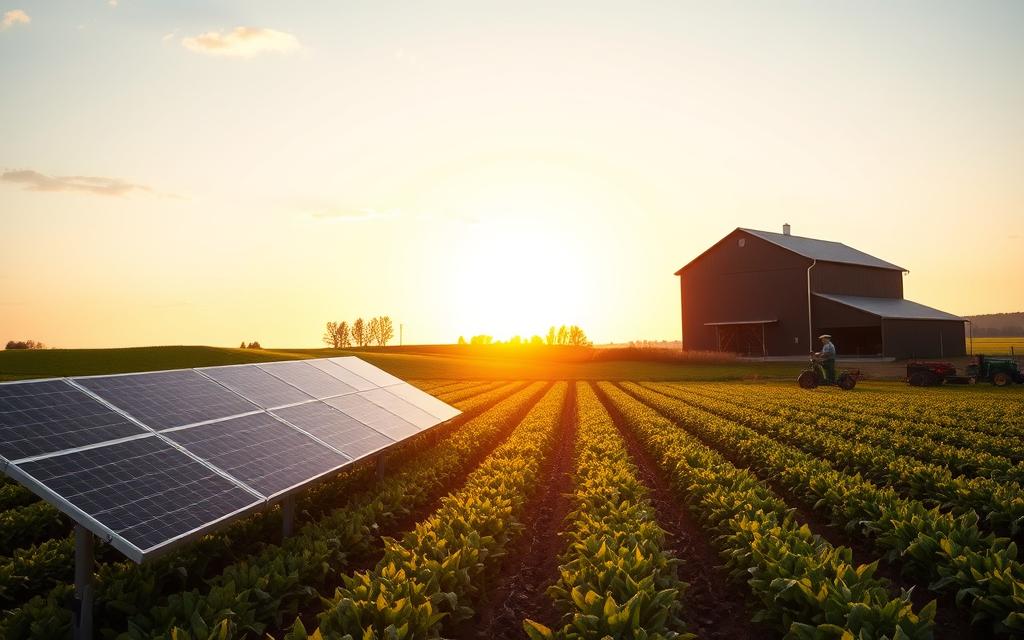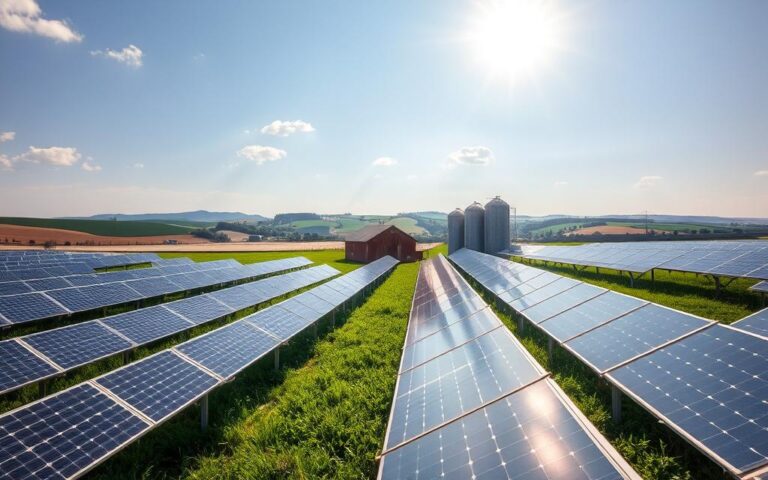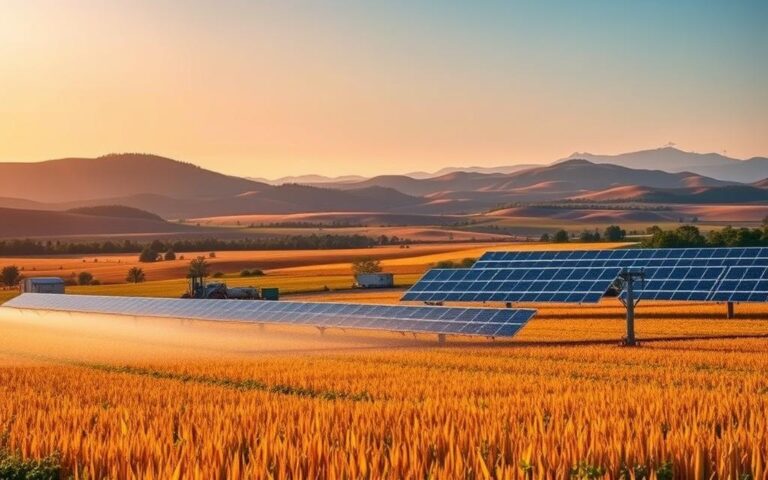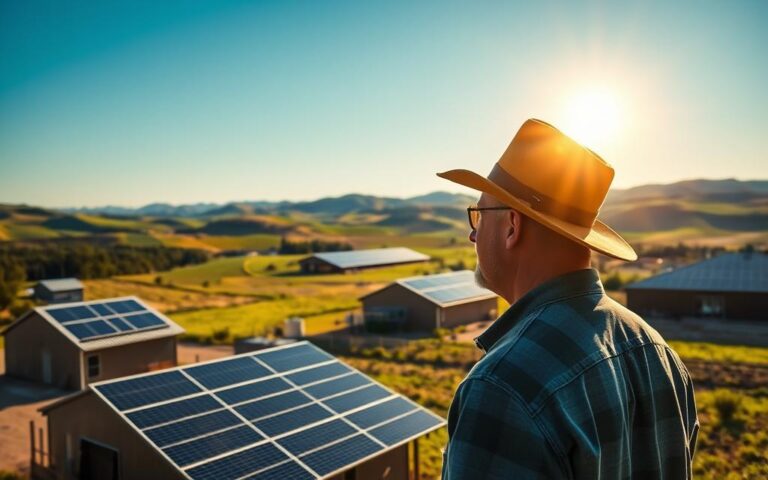Did you know solar energy can cut a farm’s energy costs by up to 70%? As energy prices keep rising, many farmers are looking for green solutions. Solar power for farming is a big help. It lets farmers save on energy and help the planet by cutting down on harmful emissions.
In this article, we’ll dive into how solar energy can boost your farm’s profits and sustainability.
The Rising Cost of Energy for Farmers
The agricultural sector is facing a big challenge with rising energy costs. These costs affect how farmers work and their profits. Electricity prices for farmers have gone up a lot, making it hard for them to keep farming.
Electricity bills can change a lot, making it tough for farmers to plan their budgets. This unpredictability makes it hard for farmers to know how much they will spend on electricity.
Many farmers are now looking at new ways to get energy. They are turning to renewable energy, like solar power. Solar power is a good choice because it costs less and is more reliable. It helps farmers control their energy costs better.
Understanding Solar Power and Its Benefits
Solar power offers many benefits, especially for farmers looking to improve their operations. The solar energy benefits for farmers include big savings on energy costs. By using sunlight, farmers can turn renewable energy into electricity they can use.
This method not only cuts down on electricity bills but also shields against price changes. It’s a smart way to save money.
Using solar energy fits well with sustainable agriculture practices. Solar systems help farmers adopt eco-friendly farming methods. This move reduces the carbon footprint of farming, making the environment healthier.
Solar installations also help farmers save money in the long run. Many farmers see big savings over time.
Adding solar technology to farming operations meets current energy needs. It also opens up chances to use renewable energy advantages. Farmers can become less dependent on fossil fuels.
Government incentives for solar energy make it even more appealing to invest in solar power.
The move towards solar-powered agriculture is a step towards a greener future for food. As more farmers join, they help create innovative, cost-effective, and eco-friendly energy solutions.
How Solar Power Works on Farms
Solar power uses sunlight to make electricity through photovoltaic panels. This clean energy helps farms by giving them a steady power source. It cuts down on the need for old energy sources.
By using solar farming methods, farms can make more energy. This leads to lower energy bills and helps the planet. Farms choose from ground-mounted or rooftop systems, depending on their needs.
For farms wanting to be energy-independent, off-grid solar systems are perfect. These systems let farmers make their own power, away from the grid. This move saves money and makes farms more self-sufficient.
Farmers should design their solar systems to match their energy needs. A well-thought-out plan ensures the systems work well and save money. This supports the farm and helps the environment.
Real-World Savings: Case Studies of Solar Implementation
Using solar power in farming has brought big financial wins for farmers in the U.S. Many case studies show how dairy and fruit farms are using solar energy. They’re cutting costs and improving their operations.
Dairy Farm Cost Savings
Dairy farms save a lot by using solar energy. A 10-kilowatt solar system can make about 10,950 kWh a year. This is great for dairy farms, which need a lot of electricity for cooling and machinery.
In one case, a dairy farm cut its yearly electricity bill from $5,816 to $3,936. This shows how solar power can save money.
Fruit Farm Energy Needs
Fruit farms also benefit from solar energy, especially for cold storage. These units keep produce fresh longer. This cuts costs and boosts energy efficiency.
By using less traditional energy, fruit farms save money. They can then use more resources for other important farm tasks.
Solar-Powered Agriculture: Financial Incentives and Rebates
Farmers looking into solar energy can find many financial help options. The Inflation Reduction Act has made it easier for farmers to switch to solar. This support can greatly reduce the cost of solar systems.
There are programs at both state and federal levels offering solar rebates. For example, solar incentives can cover up to 30% of the costs. This makes solar panels more affordable for farmers.
By knowing about these financial resources, farmers can get the most out of solar. These incentives not only help the environment but also save money in the long run.
| Incentive Type | Description | Potential Savings |
|---|---|---|
| Federal Solar Tax Credit | 30% tax credit on solar installation costs | Up to $30,000 on a $100,000 installation |
| State Grants and Rebates | Varies by state, often covering initial costs | Up to $10,000 depending on the state |
| SDRE Grant Program | Specifically for diverse farmers transitioning to solar | Up to $15,000 for eligible farms |
Strategies for Sustainable Farming with Solar Energy
Farmers are now using solar energy to make their farming more eco-friendly. This move helps them save on energy costs and make their land more productive. We’ll look at how to mix solar energy with farming and the good things about agrivoltaics.
Integrating Solar into Traditional Farming Methods
Farmers can easily add solar panels to their usual farming ways. They can put solar panels on barns, sheds, or other places on the farm. This way, they use space they already have and don’t mess up the land.
By doing this, farmers can control their energy use better. It helps them support sustainable farming even more.
Utilizing Agrivoltaics for Dual Benefits
Agrivoltaics is a new way to use land better. It puts solar panels over crops, so you can grow food and make solar energy at the same time. This method helps crops grow better by giving them shade and makes renewable energy.
This shows how solar energy can help farming in two big ways. It makes farming more profitable and better for the planet.
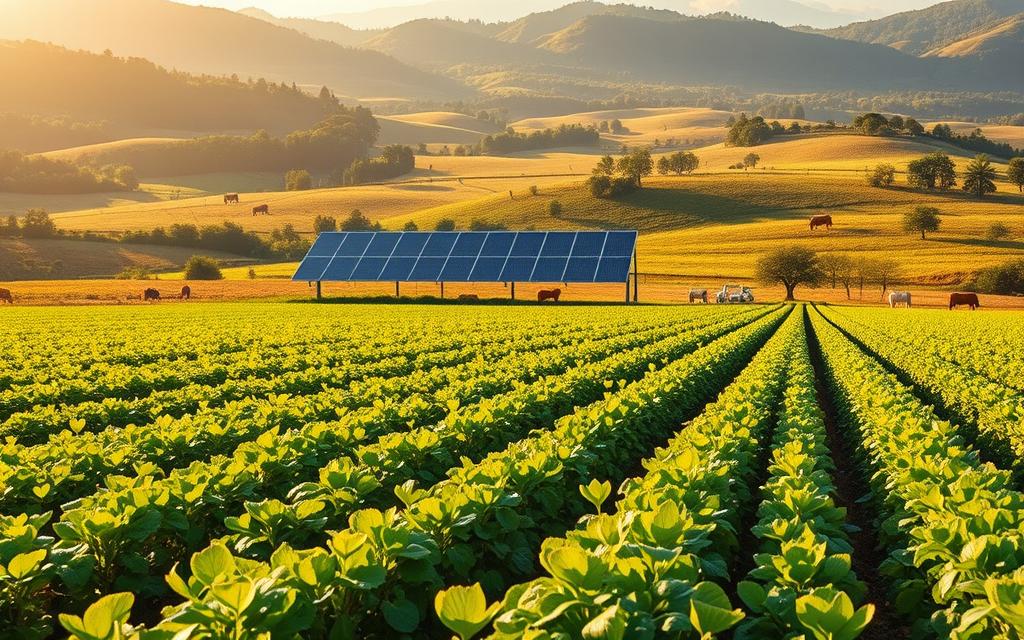
The Environmental Impact of Solar Energy on Agriculture
Solar energy brings big benefits to farming. It cuts down on fossil fuel use, which helps lower greenhouse gas emissions. This change helps make farming better for the environment, leading to healthier ecosystems.
Using solar energy fits well with farming that’s good for the planet. It lets farmers grow crops and keep natural areas safe. Solar panels need less land than old energy sources, so they help keep habitats intact.
Solar energy also helps reduce carbon footprint in farming. It lets farmers use clean energy, making farming better for the planet. This clean energy makes farms stronger against climate changes.
Challenges and Considerations in Solar Energy Adoption
The benefits of solar energy for farms are clear, but there are challenges too. High initial costs can stop farmers from going solar. It’s important to understand the considerations for solar installation before making a decision.
Things like local rules, land quality, and energy needs are key. They help decide if solar is right for a farm.
Farmers might face barriers like not knowing enough about solar or finding money. Talking to experts can help. The U.S. Department of Agriculture has resources that can help with these challenges.
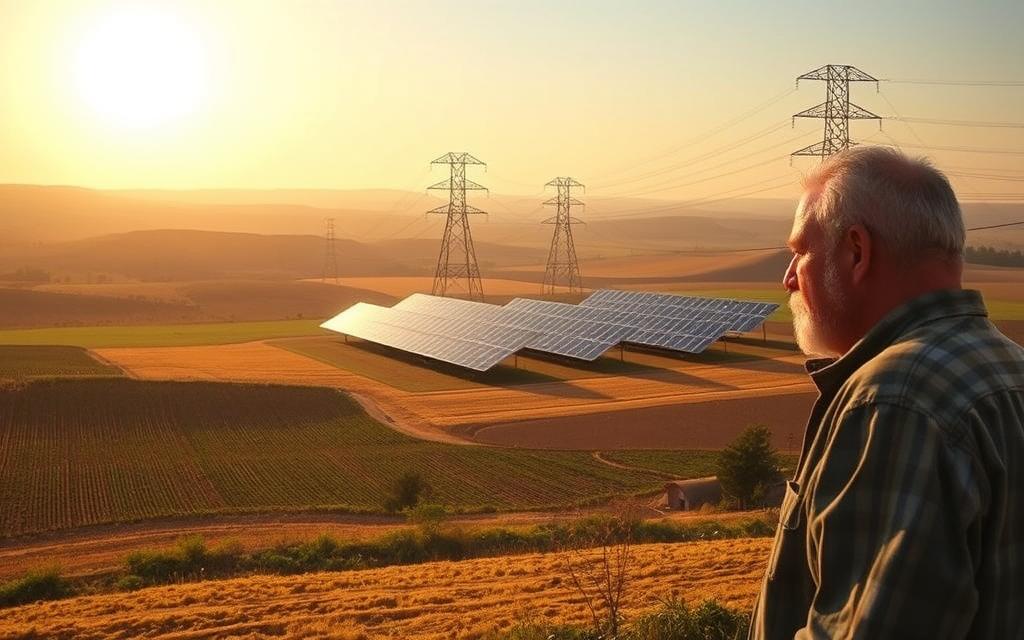
Conclusion
Energy costs are rising for farmers in the United States. Solar power is becoming key for farms. It helps farmers save money and protect the environment.
Looking ahead, solar energy is crucial for farming. Many farmers have seen big savings with solar systems. This makes their farms more profitable and resilient.
Financial help makes switching to solar even better. It’s not just a trend for farmers. It’s a smart move for a sustainable future in farming.

